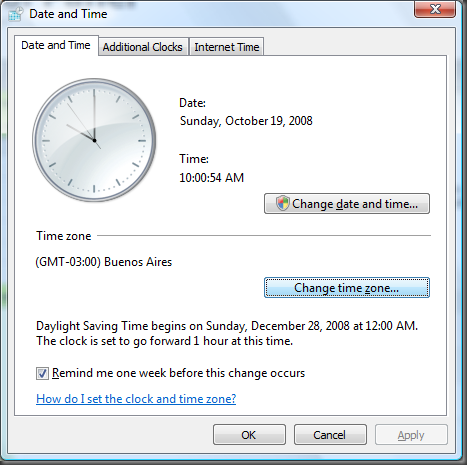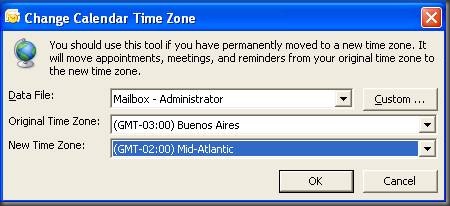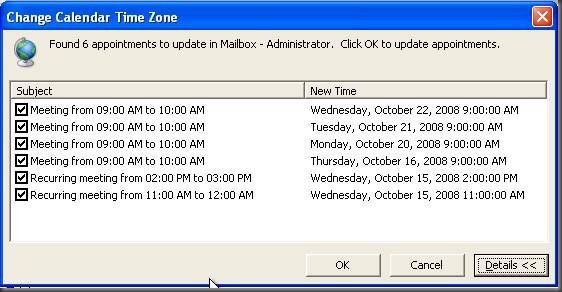Changing Windows Operating Systems time zone to ‘(GMT -2:00) Mid Atlantic’
Introduction
The Argentinean government has announced new start and end dates for the Daylight Saving Time in Argentina for the period of 2008-2009. The new daylight saving time for Argentina is the following:
- Daylight saving time begins: October 19th, 2008
- Daylight saving time ends: March 15th, 2009
Since the new dates published by the government are different from what was defined in the previous years, Windows-based computers will not correctly interpret the time that is related to the transition to daylight saving time.
Customers have two options to adjust Windows PC Operating Systems with the new dates for Argentina time zone defined by the government. We recommend every customer to read and understand the limitations of every one of these options. Please read this post to better understand the impacts of every option before adjusting the operating systems.
Changing Windows Operating Systems time zone to ‘(GMT -2:00) Mid Atlantic’
Warning: this step should to be completed only after October 19th, 2008.
In order to change the computer time zone to ‘(GMT -2:00) Mid Atlantic’, please follow the steps below:
For Windows Vista or Windows Server 2008 machines:
1. Click Start and type:
timedate.cpl
2. Click ‘Change time zone…’ button:
3. Select ‘(GMT 02:00) Mid-Atlantic’ and click OK:

Note: The option ‘Automatically adjust clock for daylight saving changes’ can be ignored in this case
For Windows 2000, Windows XP and Windows Server 2003 machines:
1. Click Start button, select ‘Run’ and type the following command:
timedate.cpl
2. Click ‘Time Zone’ tab and select ‘(GMT 02:00) Mid-Atlantic’:

Note: The option ‘Automatically adjust clock for daylight saving changes’ can be ignored in this case.
Automatically changing machine time zone to ‘(GMT -2:00) Mid Atlantic’ on Active Directory environments
Warning: this procedure is only supported in Windows 2000, Windows XP and Windows Server 2003 Operating Systems. Users running Windows Vista or Windows Server 2008 will have to use the procedures specified in ‘Changing Windows OS time zone to ‘(GMT -2:00) Mid Atlantic’’ section.
On Active Directory environments, administrators may want to automate the change of time zones to ‘(GMT 02:00) Mid-Atlantic’. This section explains how to deploy this time zone change via startup script. These procedures need to be executed in a Domain Controller or another machine with Admin Tools installed.
After performing all the steps below, all machines need to be restarted to automatically change the computer time zone. To avoid restarting a specific machine, please execute the procedures ‘Changing Windows PC Operating Systems time zone’ above to move this machine to ‘(GMT 02:00) Mid-Atlantic’ time zone.
Use a script to change the machine time zone to ‘(GMT -2:00) Mid Atlantic’
The script below can be used to change the current time zone to ‘(GMT -2:00) Mid Atlantic’ of the client computer. Then, the script writes an event to the Application log of the client computer where the script was run.
1. Click Start, click Run, type notepad, and then press ENTER.
2. Copy the following code, and then paste it into the Notepad document.
On Error Resume Next
strNewTimeZone = "Mid-Atlantic Standard Time"
Set objSh = CreateObject("WScript.Shell")
'Get the StandardName key of the current time zone
szStandardName = objSh.RegRead("HKLM\SYSTEM\CurrentControlSet\Control\TimeZoneInformation\StandardName")
'Enumerate the subkeys in the time zone database
Const HKEY_LOCAL_MACHINE = &H80000002
Set objReg = GetObject("winmgmts:{impersonationLevel=impersonate}!\\.\root\default:StdRegProv")
szTzsKeyPath = "SOFTWARE\Microsoft\Windows NT\CurrentVersion\Time Zones"
objReg.EnumKey HKEY_LOCAL_MACHINE, szTzsKeyPath, arrTzSubKeys
'Step through the time zones to find the matching Standard Name
szCurrentTzKey = "<Unknown>"
For Each subkey In arrTzSubKeys
strTimeZoneStandarName = ""
strTimeZoneStandarName = objSh.RegRead("HKLM\" & szTzsKeyPath & "\" & subkey & "\Std")
If (strTimeZoneStandarName = szStandardName) Then
'Found matching StandardName, now store this time zone key name
szCurrentTzKey = subkey
End If
Next
Dim process, processid, result, strUpdateCommand
Set process = GetObject("winmgmts:{impersonationLevel=impersonate}!\\.\root\cimv2:Win32_process")
'Add time change privilege to the process object
process.Security_.Privileges.AddAsString "SeSystemTimePrivilege", True
strUpdateCommand = "control.exe timedate.cpl,,/Z" & strNewTimeZone
'Launch control.exe to change time zone using the TZ key name stored in strNewTimeZone
result = process.Create(strUpdateCommand, Null, Null, processid)
If result <> 0 Then
objSh.LogEvent 1, "Process to change machine time zone failed to execute on this computer. Unable to change machine time zone."
wScript.Quit 0
End If
'Get the display name from previous time zone and compare with the new time zone
szPrevDispName = objSh.RegRead("HKLM\" & szTzsKeyPath & "\" & szCurrentTzKey & "\Display")
szNewDispName = objSh.RegRead("HKLM\" & szTzsKeyPath & "\" & strNewTimeZone & "\Display")
'Write entry to the Application event log stating that the update has executed
If szPrevDispName = szNewDispName Then
objSh.LogEvent 4, "Machine time zone was refreshed. The current time zone is: " & Chr(13) & Chr(10) & Chr(13) & Chr(10) & szNewDispName & "."
Else
objSh.LogEvent 4, "Machine time zone was changed from: " & Chr(13) & Chr(10) & Chr(13) & Chr(10) & szPrevDispName & Chr(13) & Chr(10) & Chr(13) & Chr(10) & "To: " & Chr(13) & Chr(10) & Chr(13) & Chr(10) & szNewDispName & "."
End If
3. On the File menu, click Save As.
4. Select a destination, and then type “ChangeTZ.vbs” in the File name box.
5. In the Save as type box, click All Files, and then click Save.
6. Double click in the ChangeTZ.vbs to refresh time zone information.
Note: Microsoft provides programming examples for illustration only, without warranty either expressed or implied. This includes, but is not limited to, the implied warranties of merchantability or fitness for a particular purpose. This article assumes that you are familiar with the programming language that is being demonstrated and with the tools that are used to create and to debug procedures. Microsoft support engineers can help explain the functionality of a particular procedure. However, they will not modify these examples to provide added functionality or construct procedures to meet your specific requirements.
Deploying time zone changes using Group Policy
1. Click Start, click Run, type notepad, and then press ENTER.
2. Copy the following lines, and then paste it into the Notepad document.
@echo off
ver |find /i "6.0">nul
IF %errorlevel% EQU 0 GOTO end
cscript \\contoso.com\NETLOGON\ChangeTZ.vbs
:end
Note: You must replace the \\contoso.com notation above with the actual DNS domain name for your Active Directory domain.
3. On the File menu, click Save As.
4. Select a destination, and then type ChangeTZ.cmd in the File name box.
5. In the Save as type box, click All Files, and then click Save.
1. Copy the following files to the Netlogon share folder of the domain controller that holds the PDC emulator role in the domain:
ChangeTZ.cmd
ChangeTZ.vbs
6. Wait until Active Directory replication occurs. Also, wait until the files and folders in the system volume (SYSVOL) shared folder replicate to domain controllers in the domain.
7. Click Start, click Run, type control admintools, and then click OK.
8. Double-click Active Directory Sites and Services.
9. Select a site where the computers in Argentina are located. (Small environments may have only a site named ‘Default-First-Site-Name’).
10. Right-click this site, and then click ‘Properties’.
11. Click the Group Policy tab, click New, type DST Time Zone Change, and then press ENTER.
12. Click Edit. The Group Policy Object Editor tool starts.
13. Expand Computer Configuration, expand Windows Settings, and then click Scripts (Startup/Shutdown).
14. Double-click Startup, and then click Add.
15. In the Script Name box, type the universal naming convention (UNC) path of the ChangeTZ.cmd file that is located in the Netlogon share. For example, type:
\\contoso.com\NETLOGON\ChangeTZ.cmd
16. Click OK two times.
Adjusting Outlook calendars for users in Argentina who moved to '(GMT -02:00) Mid-Atlantic’
As soon as you move to the time zone '(GMT -02:00) Mid-Atlantic", all Outlook calendar items from Sunday, October 19th, 2008 to Saturday, December 28th, 2008, will be displayed 1 hour off. You delta period may be even bigger depending on the time zone you were previously using, such as '(GMT -03:00) Buenos Aires, Georgetown'.
Options to correct your Outlook calendar in this scenario:
- Manually modify each appointment on the affected months (Sunday, October 19th, 2008 to Saturday, December 28th, 2008) after the operating system time zone has been changed. Instructions on the section “How to manually modify Outlook Calendar items”
- or -
- Customers may also opt to use the "Outlook Time Zone Data Update Tool version 3.0" on the mode Permanent Time Zone Move to correct the Outlook calendar items. This procedure is explained below.
Special note: We recommend you to print your calendar before any changes are made, and then review the calendar items to make sure these items appear at the correct times. You can use this printed copy of the calendar items to verify that Outlook has been updated successfully.
Step by step procedure to use “Outlook Time Zone Data Update Tool version 3.0” after a time zone move
The following describes the steps to be followed by end-users performing a time zone move:
The steps below can be followed for users who changed their time zone configuration to “(GMT -02:00) Mid-Atlantic”.
Download and run the installation package from:
Go to Start, All Programs, Microsoft Office Outlook Tools, Time Zone Data Update Tool and Select "Permanent Time Zone Move Mode".
Properly select “(GMT -03:00) Buenos Aires” (or '(GMT -03:00) Buenos Aires, Georgetown') from the “Original Time Zone:” drop down, and “(GMT -02:00) Mid-Atlantic” for the “New Time Zone:” drop down and click OK.
Note: As with standard time zone updates, the tool defaults to updating affected items on your Calendar and in your Reminders folder. If you would like to update additional items (e.g. items in additional Calendars or a PST), you can do so by clicking the ‘Custom…’ button and manually selecting the target folder.
- The tool will inspect your mailbox and will report how many appointments will be moved:
If you click “Details” the appointment list will appear and you will be able to select all (default) or some of the appointments. In a normal situation you will move all the appointments to the new time zone. Click “OK” in the following dialog to proceed moving the appointments. A log file “Outlook Time Zone Update .log” will be generated in the %temp% directory.
- Click "OK" to correct the calendar items listed.
- After moving Click “OK” again to close the tool.
Review your calendar items from Sunday, October 19th, 2008 to Saturday, December 28th, 2008 and verify they were correctly updated.
How to manually modify Outlook Calendar items:
Either if you decide to update the time zone '(GMT -03:00) Buenos Aires' or move from another time zone to '(GMT -02:00) Mid-Atlantic", your calendar items will be one hour off on the Delta Period, from Sunday, October 19th, 2008 to Saturday, December 28th, 2008. You delta period may be even bigger depending on the time zone you were previously using, such as '(GMT -03:00) Buenos Aires, Georgetown'
A simpler alternative to correct the Outlook Calendar items is by adjusting the appointments manually. To do so, please proceed as follows:
1. Start Outlook, and then open the Outlook calendar.
2. Manually move each meeting that you organized so that they occur at the correct time.
3. Send an update for each meeting that you moved to the meeting attendees. This action causes the calendar for each attendee to display the correct time for the meeting.
4. Manually move each single-instance appointment.
5. Manually move all recurring appointments that occur in the extended DST period.
Recommendations to minimize the impacts on Outlook/Exchange:
- Simulate the changes on a lab environment, so you know what will happen and what to expect.
- Work in conjunction with the operating system team to update the DST dates as soon as possible to minimize the chance of users creating new appointments during the delta period before the operating system DST dates get updated.
- Before doing any change on the DST information, request the users to print their schedule so they have a reference to follow in order to manually update the appointments later if needed.
- Take a full online backup of your Exchange Servers in case you decide to use the Exchange Calendar Update Tool.
- For the meetings with multiple attendees only the meeting requestor should update the time and send the update to the others.
- Include the time of the meeting in the e-mail request so that invitees can double check the correct meeting time (such as, "Project brainstorming - 11:00 A.M. Buenos Aires Time").
- Exercise caution with the appointments and meetings in the extended DST period. When in doubt, verify the correct time with the organizer.
References:
941018 How to address daylight saving time by using the Exchange Calendar Update Tool
https://support.microsoft.com/default.aspx?scid=kb;EN-US;941018934001 A troubleshooting guide to the Exchange Calendar Update Tool (Msextmz.exe)
https://support.microsoft.com/default.aspx?scid=kb;EN-US;934001931667 How to address time zone changes by using the Time Zone Data Update Tool for Microsoft Office Outlook
https://support.microsoft.com/default.aspx?scid=kb;EN-US;931667957498 Outlook Time Zone Data Update Tool 2.0 and earlier versions of this tool do not correctly rebase any calendar item that was created in the Brasilia time zone
https://support.microsoft.com/default.aspx?scid=kb;EN-US;957498943390 Some Outlook calendar items are rebased incorrectly when you use the Outlook Time Zone Data Update Tool to adjust for daylight saving time changes in certain time zones
https://support.microsoft.com/default.aspx?scid=kb;EN-US;943390


